Where can you find great food, ancient buildings, Renaissance art, and landscapes that perfectly balance humans and nature’s work, all in one place? In Italy, obviously!
This relatively small country has a lot to offer to first-timers as well as experienced tourists (even to those who live in Italy already!!).

If you are looking for a heartwarming and fulfilling trip, this 2-week itinerary in Italy itinerary across completely different cities and regions is exactly what you need.
JUST INTERESTED IN NORTHERN ITALY? READ An Epic Northern Italy Itinerary for 10 Days
Table of Contents
Day 1: Fly to Rome and Start Exploring
Start your 2 weeks Italy road trip in Rome, the Italian capital and home to the Pope.
▶ If you’re coming by plane, you’ll arrive in Rome either at Ciampino Airport (south-east of the city) or most likely from Fiumicino Airport (on the west side of the larger Rome area and further away from the city center). From either airport, you’ll be able to catch a bus or a to the city center.
▶ If instead, you are traveling by train, Roma Termini (via Giolitti 2) is Rome’s historic, bustling transportation hub (many busses arrive here, too) but the city is actually full of smaller train stations—such as Roma Tiburtina or Roma Monte Mario—that may be closer to your hotel.
On your first half day in Rome, I suggest you get settled in at your hotel, grab a hat, and start exploring!
READ ALSO: The Perfect 3 Days in Rome Itinerary
You can start at Rome’s most famous square, St. Peter’s Square (technically in Vatican City…but I promise, you won’t notice the difference!).
The square faces the west end of Via Della Conciliazione, on the west bank of the Tiber river. The architect Gian Lorenzo Bernini designed it so that the square and the elliptic design of its colonnade may embrace a viewer standing at the square’s entrance. It’s a sight to behold!

Once you’ve taken it in, make your way to St. Peter’s Basilica, the biggest church in the world.
The Basilica has been standing on Roman soil since the Renaissance and is full of art, on top of being a work of art in itself. Entrance is free, just don’t let the line discourage you, and make sure to wear “church-friendly” clothes.
After your visit, you should check out nearby Castel Sant’Angelo, on the east end of Via Della Conciliazione and a 10-minute walk away from the Basilica.
This building was first started in 125 BC as a dedication to the Roman Emperor Adriano but what you admire now is the result of centuries of renovations. Feel free to walk around it, wander in the park, and take pictures of the river.

Day 2 & 3: Rome
For your second and third day in Rome, the list of top things to do is quite long, so you should plan what’s best for you according to your hotel location as well as your desires.
➤ If you’d like to know more about Vatican City after your visit to St. Peter’s Basilica, check out this Vatican Museums, Sistine Chapel & Basilica Guided Tour with skip-the-line tickets included. ➥ BOOK IT HERE
➤ Alternatively, if you don’t want a guide and would rather stroll around at your own pace, you can get the entrance tickets for the Vatican Museums and Sistine Chapel here ➥ BUY TICKETS
READ ALSO: Best Vatican & Sistine Chapel Tickets to Skip the Line
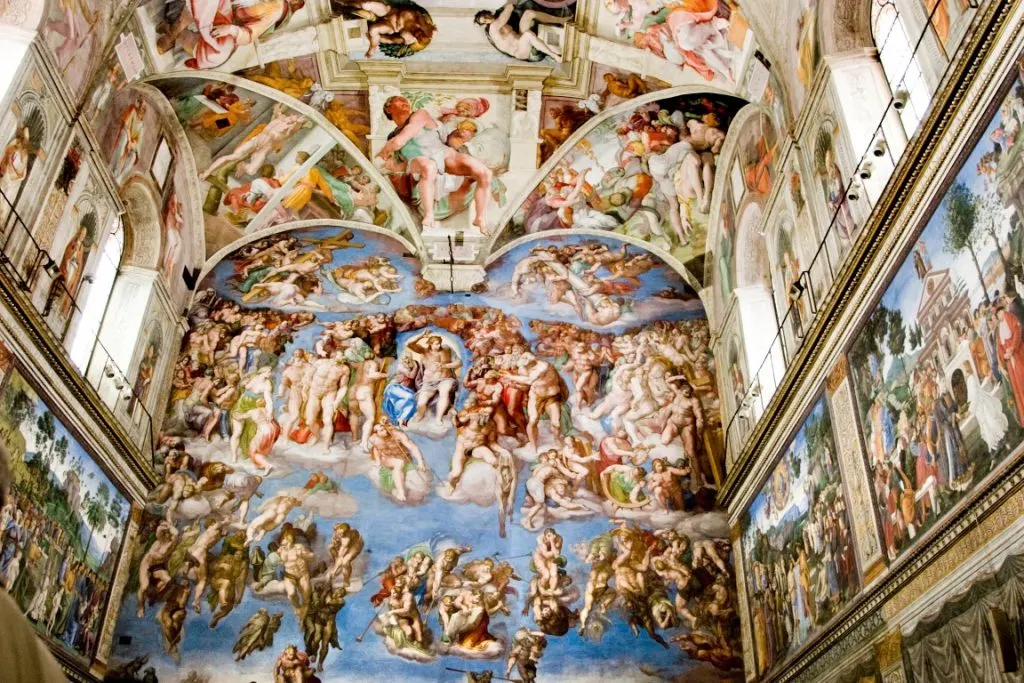
This museum hosts 7 km of art galleries and works of art, and among other beauties like the spiral staircase at the entrance, it features Michelangelo’s Sistine Chapel (a visit is included in the general admission ticket).

Not far from the Vatican Museums, you’ll find several attractions…all for free!: the Piazza di Spagna (Square of Spain), with the famous “boat fountain” and the Spanish Steps; the 18th-century Trevi Fountain; and Navona Square, which hosts a street market and several street artists next to a gorgeous decorated fountain and an obelisk.
READ ALSO: 14 Best Viewspots in Rome

For a peek into more ancient Rome, you can’t miss out on the Colosseum and the Roman Forum. Situated on the east bank of the river, the Flavio Amphitheater, or Colosseum, is Rome’s most famous site and a visit will allow you to imagine what it was like to live there and seeing all kinds of (violent and less violent) shows within its walls.
Right next to it, the most impressive evidence of pre-Renaissance Rome will sprawl in front of you. Organized as an archeological park, the Roman Forum was the economic core of ancient Rome and is now encased between the Colosseum, Palatine and Capitol Hills.
➤ If you don’t want to wait in line (and I guarantee you there will be one), I suggest you get skip-the-line tickets. These ones also give you access to the Arena floor! ➥ BUY TICKETS
➤ Alternatively, in case you prefer to enjoy Rome with the aid of a guide, this guided Premium Colosseum Tour with Roman Forum & Palatine Hill, with skip-the-line tickets. ➥ BOOK IT HERE
➤ This other Colosseum, Palatine Hill & Roman Forum Guided Tour will also take you to the same places… for almost half the money. You’re welcome! ➥ BOOK IT HERE

And if you’re a bit tired of ruins and history, why not check out these cooking classes in Rome or join a food tour around the city?
Day 4: Travel to Florence
Continue your 14-day itinerary around Italy saying goodbye to Rome and heading north towards Florence.
▶ To do so, hop on a train (high-speed train tickets start at 50€ for 1-hour-and-a-half trips, while tickets for slower trains start at 21,65€ for a 4-hour ride). The best arrival train station in Florence is Firenze Santa Maria Novella for how central and accessible it is. ➥ BUY YOUR TRAIN TICKETS HERE
▶ While in my experience traveling by train is more convenient, the bus is an option too. It takes about 3.5 hours to get from Rome to Florence by bus. ➥ BUY YOUR BUS TICKETS HERE
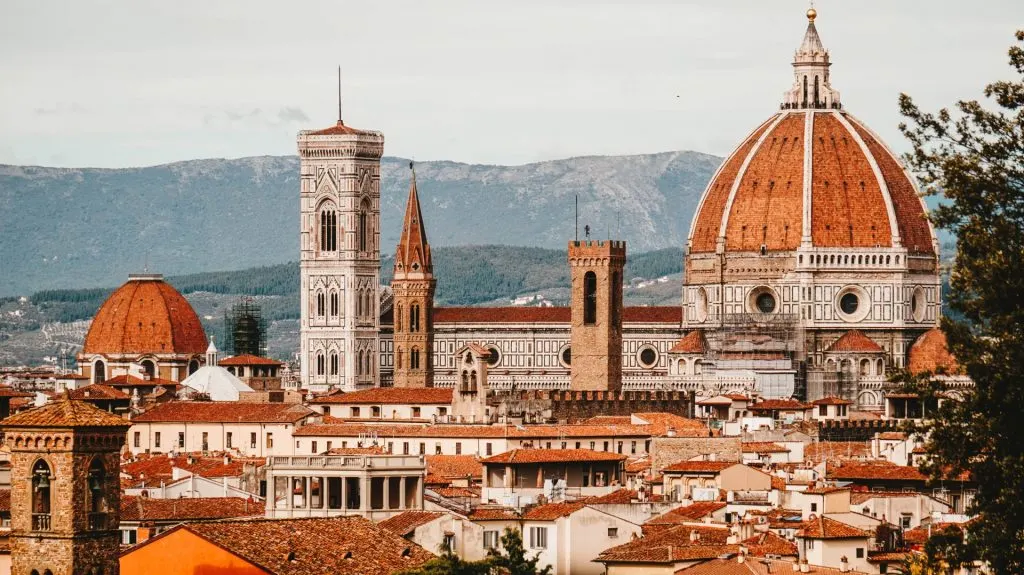
Very much like Rome, Florence is a beautiful city with a variety of amazing attractions. On your first afternoon in town, you can start from the church next to the train station, Santa Maria Novella.
Its unique black-and-white marble façade is only the beginning since the interiors are also full of wonderful frescos by Renaissance artists Filippino Lippi and Masaccio, among others.
After your visit, a 5-minute walk will bring you to the Medici’s Chapels (Piazza della Madonna degli Aldobrandini 6), a monumental complex where the most prominent members of the Florentine Medici family are buried.
Even if you’re not into history, the larger-than-life marble statues and the decorated tombs are a testament to this family’s long-lasting legacy to the city.
Finish the day by delving into the Accademia Gallery Museum, which exhibits the largest collection of sculptures by Michaelangelo, including his most famous one: the statue of David.
➤ If you would like to visit the Accademia, I recommend you get this Timed Entrance Ticket to Michelangelo’s David, so you can choose when you want to go in, skip the lines, and stay as long as you want. ➥ BUY TICKETS
Day 5 & 6: Florence
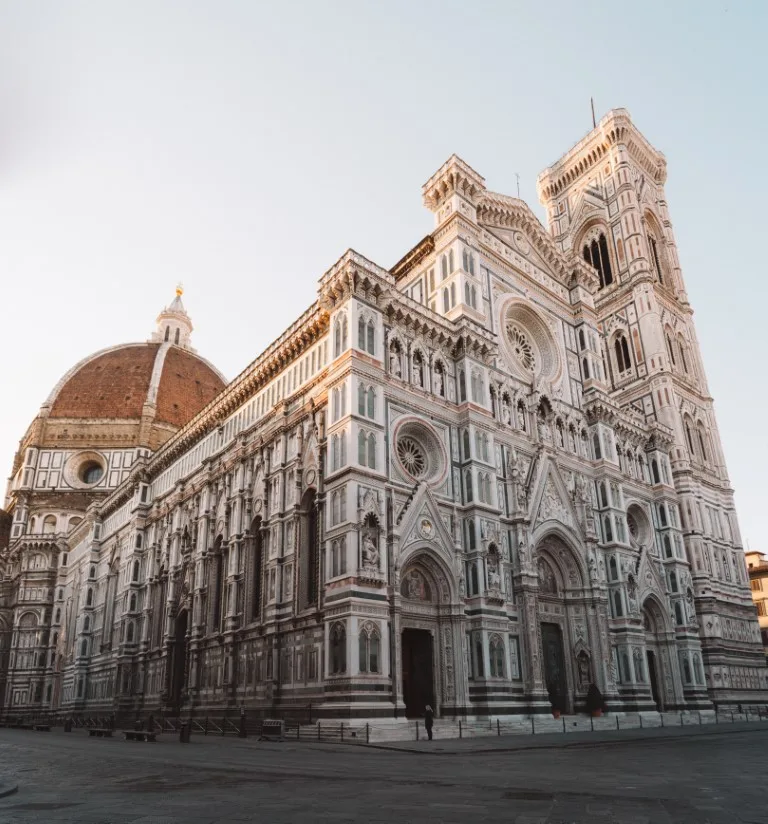
Start your next 2 days in Florence by beginning with the city’s main church, located at Cathedral Square (Piazza del Duomo): the Santa Maria del Fiore Cathedral.
The entrance to the church is free, while to access the dome, the clock tower, the terraces on the roof, and the adjacent Baptistery of Saint John you need a ticket (prices vary but several ticket combinations are available).
➤ If you want to visit the cathedral with a guide and enjoy the incredible views from the duomo, this Florence Dome Skip-the-Line Guided Tour is a perfect option for you. ➥ BOOK IT HERE
➤ For a more private experience, a good option is this Dome Climb, Museum, and Baptistry Small-Group Tour. ➥ BOOK IT HERE
➤ If you’re not a fan of tours and would rather walk around at your leisure, I recommend you buy the Premium Skip-the-Line Tickets in advance to avoid the queue. ➥ BUY TICKETS
The whole complex is breathtaking thanks to the balance between lightness of colors and shapes, large size, and considerable height. Next, a 5-minute walk through Via Dei Calzaiuoli, will bring you to the city’s central square: Piazza Della Signoria.
You’ll recognize it thanks to the equestrian statue to your left and the marble statue of David to your right.
Here, you may visit Florence’s city hall, the Palazzo Vecchio (consider a peek inside mainly for the Arnolfo tower, from where you can get a great view of the city), or the neo-gothic Santa Croce Basilica, 500 meters away (from Piazza della Signoria, take first via dei Gondi, then Borgo dei Greci straight ahead).

If you are a museum person, in Florence you must visit the Uffizi galleries back in Piazza della Signoria.
The Uffizi Galleries are the second most visited museum in Italy (after the Vatican Museums), and no wonder, since they contain an extraordinary collection of masterpiece after masterpiece by some of the most renowned artists in Italian history, like Michaelangelo, Raffaello, Botticelli and Leonardo Da Vinci.
Before purchasing tickets online, take a quick view of the highlights on the museum’s TikTok account and get ready for a jump into unforgettable art history from the Middle Ages to modern times.
➤ Given its popularity, I highly recommend you buy a Skip the Line Entry Ticket to have priority access. It will make your life much easier. ➥ BUY TICKETS
➤ If you would like to dive deeper, you can join this Uffizi Small Group Tour, in which a guide will teach you all about the history behind the galleries and their treasures. ➥ BOOK IT HERE
➤ If you are a big art lover and want to visit both museums, this Uffizi + Accademia Pass is the way to go! ➥ BUY TICKETS
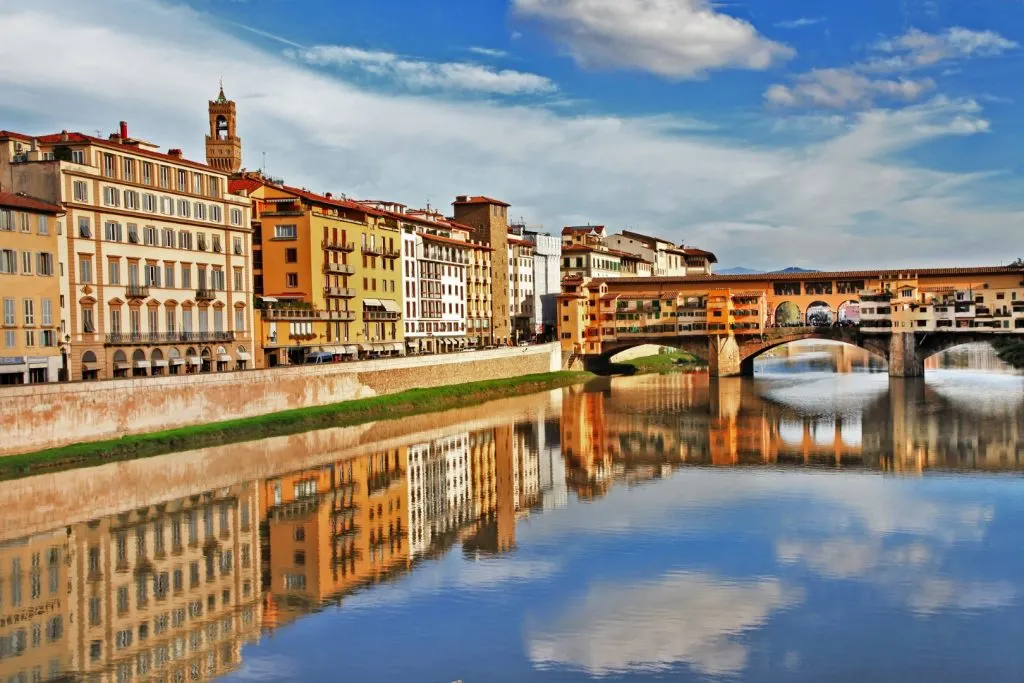
On the other side of the Uffizi building, on the north bank of the Arno river, your Florentine exploration may continue with the Ponte Vecchio, the most famous bridge on the river that goes through Florence.
Ponte Vecchio is also an incredible architectural and commercial feat, and I’m always amazed by how many tiny boutiques, vendors, customers, and travelers have been passing through this small bridge.
On the other side of the river, if you walk on Via dei Guicciardini, you’ll find the Pitti Palace to your left. This Renaissance palace has no less than 4 museums among its walls.
➤ If you’d like to visit the Pitti Palace and its museums, you can skip the lines by buying the tickets in advance ➥ BUY TICKETS
In addition, in the back of the Palace you cannot miss a walk through the gorgeous Boboli Gardens, which make it really easy and fun to imagine life in a Renaissance Italian court.
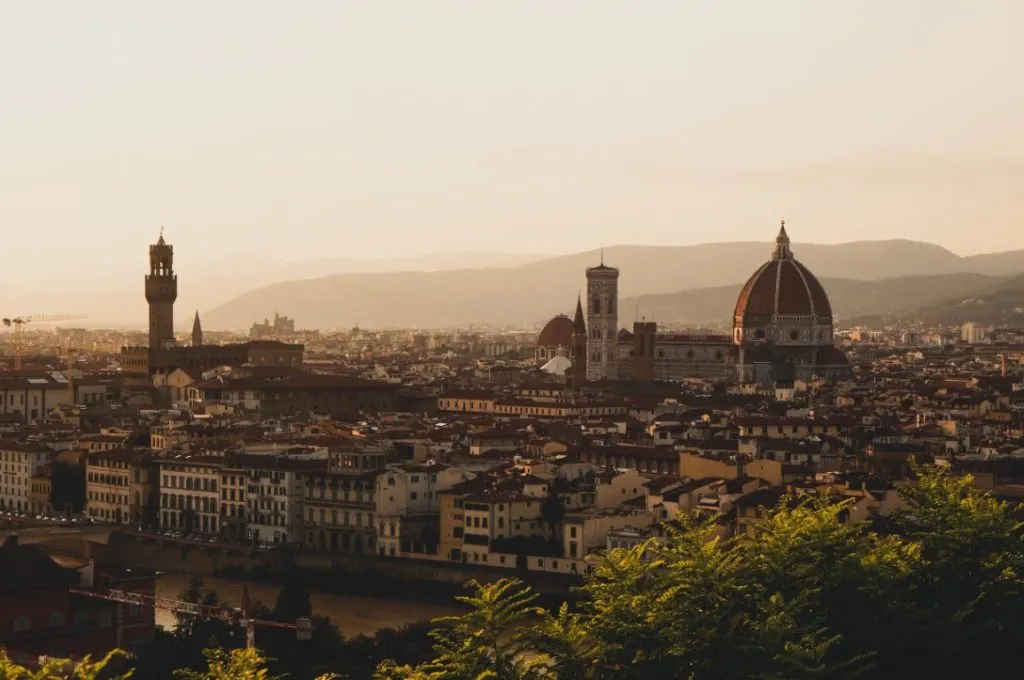
For yet another great viewpoint of the city of Florence, I recommend Piazzale Michelangelo. From the Pitti Palace, go back to the river and take a right on Via de Bardi and continue straight ahead for about 20 minutes on foot on Lungarno Torrigiani. The 19th-century Piazzale Michelangelo will show up to your right.
➤ As in Rome, if you don’t feel like organizing your own Florentine tour, check out this Best of Florence Walking Tour with David & the Duomo. An expert local guide will lead you across Florence to see Michelangelo’s works at the Galleria dell’Accademia (Via Ricasoli 58), examine the outside of Santa Maria del Fiore Cathedral, and walk through Piazza della Signoria and Piazza della Repubblica. ➥ BOOK IT HERE
Day 7: Day Trip around Tuscany

To close the first half of your 2-week tour of Italy, I suggest a day trip around Tuscany, Florence’s region and one of Italy’s most famous destinations ever.
In addition to Florence, in Tuscany, you find Pisa and its leaning tower, Siena and the horse race Palio, the Chianti vineyards, just to name a few famous spots.
Since you’re trying to see Italy in two weeks, I’m assigning only 24 hours to spend in the Tuscan countryside, but if you can stay longer, it’s really worth it!! I’ve written a full post about the perfect Tuscany itinerary for 7 days.
➤ Given the astounding range of options, my advice is to book this Tuscany Day Trip from Florence with Chianti, Siena, and San Gimignano. A knowledgeable guide will bring you to top Tuscan destinations. The tour includes lunch, wine tasting, and a pasta-making demonstration, and it doesn’t accept more than 18 people at a time. I think it’s a real bargain for everything it offers. ➥ BOOK IT HERE
➤ For a similar (yet slightly more limited) tour that offers great value for money, check out this other Tuscany Day Trip with Lunch at Chianti Winery, which includes Siena, San Gimignano, Pisa and/or Chianti. ➥ BOOK IT HERE
Day 8: Bologna
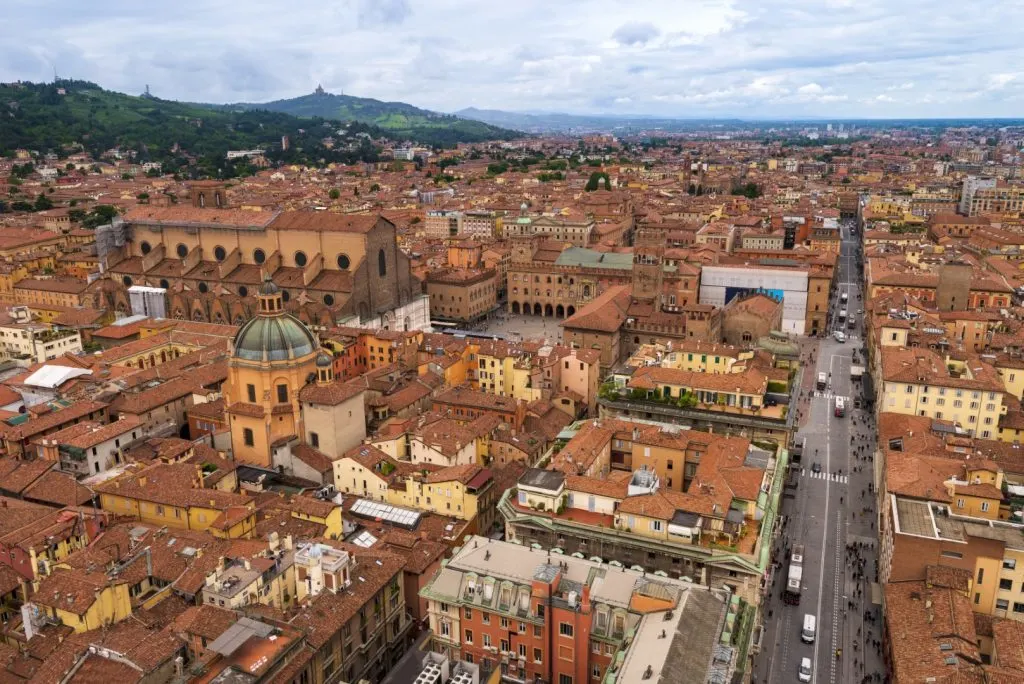
Day #8 of your 2-week Italian itinerary is Bologna day! Because Florence and Bologna are quite close to each other, the train is the best way to travel for a day trip.
Even if Bologna isn’t as famous as other destinations in Italy, there are plenty of things to do and see in Bologna – this is where I grew up and lived for the first 25 years of my life, so trust me on this!
▶ A high-speed train ride takes 40 minutes to cover 100km (tickets start at 29€), while slower trains may take up to 1 hour and 40 minutes and cost 9,45€. Regardless of speed, all trains will bring you from Firenze Santa Maria Novella to Bologna’s main train station, Bologna Centrale. ➥ BUY YOUR TRAIN TICKETS HERE
To start your one day in Bologna itinerary, take an exit on Piazzale delle Medaglie d’Oro, the station’s south entrance. Bologna’s historical downtown with red brick walls and UNESCO-recognized arcades await you!
One option here is to take Via Amendola, walk until Piazza dei Martiri, then take a left in Via Don Minzoni to visit the MAMbo (Via Don Minzoni 14), Bologna’s museum of modern art.
Alternatively, from the train station, take a left and walk straight ahead in the Via dell’Indipendenza, Bologna’s shopping venue. After a 10-minute walk, turn left in Via Righi, and get lost in the streets surrounding the University of Bologna’s medieval buildings.
Highlights in this area of town are:
• Piazza Verdi, where you may see Bologna’s Opera Theater Comunale and enjoy real student life;
• the so-called “finestrella”, Italian word for little window, (Via Piella 5), where you can look through a hole in the wall the water canals running all around the city (you read that correctly, Bologna has canals!);
• the MEB (Via Valdonica 1/5), namely, the Jewish museum in Bologna’s former Jewish ghetto.
At this point, you might be hungry, but you’re in luck. Bologna is famous for being a foodie destination, and Bologna traditional dishes include lasagne, mortadella, and other delicacies.
READ ALSO: Where to Eat in Bologna: A Guide by a Local
With a full belly, make your way to the city center, but wait, before you get there, take a look at the world’s tallest leaning tower: the Asinelli Tower (that’s right, if you thought it was the Pisa tower, think again!). There are almost 500 steps to climb, but the views are totally worth it!
➤ If you would like to get all the way to the top, you can get admission tickets that include some snacks for extra motivation ➥ BUY TICKETS
In addition, make sure to reach the city’s two core squares: Piazza Maggiore and Piazza del Nettuno (at the end of Via dell’Indipendenza).
In Piazza del Nettuno, you’ll find Sala Borsa, the city’s central public library, with its glass floors overlooking ancient ruins, as well as the square’s namesake, the Neptune fountain. Before going, make sure to learn about the 7 secrets of Bologna so you can laugh here!
If you walk across the square, Piazza Maggiore will open to your left and you’ll see the unfinished façade of San Petronio Basilica, the largest church in town with exquisite artworks encased in its 22 chapels.
Last but not least, in Bologna you’ve got to see Piazza Santo Stefano (from Piazza Maggiore, take via Clavature and turn right on Via Santo Stefano). This piazza has a very unique triangle shape and leads to Santo Stefano Abbey, a church with seven altars that you can visit with a free donation.
➤ If all that information was a bit overwhelming and sounds like a pain to navigate on your own (I get it, it’s a lot), I suggest this 2-hour City Center Walking Tour that will take you to the main sights in central Bologna. ➥ BOOK IT HERE
➤ Even better, if you want to combine your stroll around Bologna with the excellent food this region is famous for, this Self-Guided Food Tasting Tour with Vouchers is a great choice. You can walk the city at your pace while picking up food along the way. Oh yes. ➥ BOOK IT HERE
Before heading back to Florence, this is also the perfect place where to do a happy hour with the traditional Spritz drink.
Day 9: Travel to Cinque Terre

Now leave cityscapes behind and explore the Liguria region, in north-western Italy. I specifically suggest going to Cinque Terre, a UNESCO heritage site and a national park featuring terraced vineyards, hikes overlooking the Mediterranean Sea, and 5 picturesque hamlets hanging over cliffs.
The five hamlets are Riomaggiore, Corniglia, Manarola, Vernazza, and Monterosso al mare. They all have a train station so the best thing to do is booking a train ticket from Firenze Santa Maria Novella to one of the five hamlets, depending on where you’re staying.
▶ From Florence, you’ll have to cover about 150km and a train ride to Riomaggiore, for instance, takes about 2 hours and thirty minutes with 2 changes of train, with tickets starting at 14,60€. ➥ BUY YOUR TRAIN TICKETS HERE
On your first afternoon in Cinque Terre, you can start right away by exploring the hamlet where you’re staying.
Do some shopping for craft souvenirs, take pictures of the golden sea at sunset, walk to the sea from the high-standing Corniglia using the 33 flights of stairs or relax on the beach in Monterosso al Mare.

Another option is getting to know the products and cultivations of the park, such as lemons, honey, and wine.
For wine, in particular, local farms like Terre Sospese and Cooperativa Agricoltura 5 Terre by Riomaggiore offer wine tasting and tours of their properties, in addition to selling wine by the bottle! Consult this list of wine producers to find the one closest to you.
For your food stops, make sure not to miss a plate of “spaghetti ai frutti di mare” (spaghetti with seafood) at one of the several fish restaurants you’ll find on your way.
Day 10: Cinque Terre

Dedicate your itinerary’s tenth day to enjoying the natural beauty of Cinque Terre thanks to the many hiking trails available.
They are all meticulously marked with signs in white and red and their difficulty varies, going from the trail 530 Telegrafo-Volastra (open to all levels, 2h40m approx. length) to trail 507 Vernazza-San Bernardino (for expert hikers, 2h20m), just to give two examples.
Another type of trail is the one that links all sanctuaries and churches across the five hamlets (for expert hikers, 6h45m).
In any case, my suggestion is to always check out the park’s website in the morning before your hike for the trail network and for up-to-date information on the weather forecast and trail accessibility.
Once you’ve chosen the trail for you, I assure you that you’re going to love this little adventure and thank yourself for putting in the energy. Nothing matches what you’ll see on the top of the cliff, after hiking among the vines.
If instead, you prefer water to the land, consider renting kayaks at one of the 5 harbors (just make sure to follow the buoyed-mark water paths) or do some diving in the Mediterranean Sea.
➤ If you don’t want to do it on your own, this Guided Cinque Terre Kayak Tour will take you paddling quietly along the Italian Riviera to enjoy the Cinque Terre villages from a unique perspective, lunch break and all. Totally worth it. ➥ BOOK IT HERE
Day 11: Milan
After your time in the Cinque Terre national park, my recommendation is to spend the last 4 days of your two-week Italy itinerary in the cities of Milan and Venice.
Milan is about 225km north of the Ligurian coast and is easily accessible by train.
▶ There are many ticket combinations available, but my advice is to book a seat on the Intercity train that in 3.5 hours and one change will bring you to Milan’s main station Milano Centrale ➥ BUY YOUR TRAIN TICKETS HERE
After your arrival in Milan, you should hit the city’s top touristic destinations right away, such as the Duomo Cathedral in the central Cathedral Square (Piazza del Duomo), the Brera Art Gallery (Via Brera 28) just north of it, and the Sforza’s Castle in Piazza Castello, on the north-western edge of the historical city center.

If you do visit the Duomo, next to gazing at its highly decorated façade and beautiful interiors, make your way up to the roof. Thanks to the stunning view of the city, Fran and I thought that going to the top of the Duomo was the highlight of our stay in Milan.
➤ With this Milan Cathedral and Duomo Terraces Entry Ticket, you get access to all the areas of the cathedral, including the duomo. ➥ BUY TICKETS
➤ If you want to know more about what it is that you’re looking at, this Fast-Track Milan Cathedral and Terraces Guided Tour is a great option, since it’s only for small groups, with a private option as well, and fast-track tickets. ➥ BOOK IT HERE
READ ALSO: Visiting the Milan Duomo: Tickets & Tips
A visit to the Brera Art Gallery, on the other hand, may be perfect to complement the Italian art you have seen in Rome, Florence, and Bologna.
For something off the beaten path but still very much connected to Milanese history, consider a stop at the Armani/Silos (Via Bergognone 40), southwest of the larger Milan area.
This exhibition space created by and about Italian fashion designer Giorgio Armani is where his most famous pieces are put on display and discussed for their innovation and relevance to fashion history.
On your Italian itinerary’s eleventh evening, make sure to check out one of the many fish restaurants in Milan, like Osteria di Brera (Via Fiori Chiari 8) and Capra e cavoli (Via Pastrengo 18), which perfectly combines a vegetarian and vegan cuisine with great fish offering.
These two restaurants are also conveniently located near one of the most famous nightclubs in Milan, Alcatraz (Via Valtellina 25). If you’re in for a night of dancing, DJing, and Italian nightlife, you cannot miss out on it.
Day 12: Travel to Venice
The next day, you have two options: you can spend the morning in Milan or make your way straight away to Venice, the last destination of this itinerary for two weeks in Italy.
If you decide to stay in Milan for a few more hours, my recommendation is to let an expert local guide lead you across town to see Leonardo da Vinci’s fresco The Last Supper, the Duomo, and the nearby Vittorio Emanuele II Gallery.
➤ If you haven’t seen some of these beauties yet, this Best of Milan Tour will take care of it. It’s convenient, well-organized, and guarantees skip-the-line tickets to The Last Supper. ➥ BOOK IT HERE
Once you’re ready to leave Milan (early in the morning or after the guided tour), take a train to Venice.
▶ From Milano Centrale to the Venetian main station, Venezia Santa Lucia, there is about 260 km. High-speed train rides are 2 hours and 30 minutes (starting from 49€), while slower trains take 3 hours and a half for half the price. ➥ BUY YOUR TRAIN TICKETS HERE
Regardless of the train, I really love arriving at Venezia Santa Lucia. Literary just outside of it, there’s a feast of canals, decorated churches, and bridges over the Grand Canal (Venice’s main water artery). It’s just unmatchable!

From the train station, you can explore the city by taking a left and immerse yourself in the Cannaregio neighborhood. Not many tourists venture here, thus missing not crowded Venetian alleys and an uncharted walk into Europe’s most ancient Jewish ghetto.
If you’re interested in history, Venice’s Jewish museum (Campo di Ghetto Nuovo) is a great place to start.
From Cannaregio, you can easily walk to the rest of Venetian attractions, including the Rialto Bridge, the nearby Rialto fish market (and open-air food market that I recommend visiting to get a sense of the “lived” Venice!), and the high-end shopping center Fondaco dei Tedeschi.
In the Rialto neighborhood, also consider visiting the bookstore Libreria Acqua Alta, where alternative book storage (on a gondola and in a bathtub, among others) makes a touristic attraction of the high-water phenomenon and the centuries-old Venetian tradition of book printing finds its place in the twenty-first century.

Day 13 & 14: Venice
On your second and third day in Venice, complete your two weeks in Italy by visiting the Venetian top square, San Marco square.
Here, you may find an astounding list of great things to see: the Saint Mark’s Basilica (its core standing since 832 BC and the real symbol of the city with its 5 domes), and the Doge’s Palace (home to Venice’s traditional leader as well as the governmental palace of the Republic of Venice) are iconic ones.
There’s also the Correr Museum (exhibit art related to the history of the city), and the Marciana national library, a real paradise for book lovers and architecture fans.
➤ If you would like to visit Doge’s Palace alone, you can get Reserved Entry tickets so you don’t have to wait in line. ➥ BUY TICKETS
➤ If you would rather go with a guide to learn more, this Doge’s Palace & St. Mark’s Basilica with Terrace Access Tour includes priority entry and access to the Basilica’s terrace. ➥ BOOK IT HERE
If you have time, also consider a tour of the Peggy Guggenheim Collection, a twentieth-century art collection in a 1700 building that you’ll find on the other side on the Accademia Bridge (south-west of San Marco square), overlooking the Grand Canal.
Would you rather experience Venice without the planning but all the fun?
➤ This Welcome to Venice Walking Tour offers a peek into San Marco Basilica, the Rialto Bridge and fish market, the house of Marco Polo, Santa Maria dei Miracoli church, and…a gondola ride!
Considering that gondola rides are quite expensive (you would spend at least 80€), I really recommend this tour if you are looking for a much more affordable way to enjoy Venice with a group and a local guide. ➥ BOOK IT HERE

If you want to spend the day in a slightly different way, a great option is to head to the colorful islands of Burano, Murano and Torcello, well-known for their artisan shops.
Getting on this boat trip tour will make things far easier for you. It includes an expert guide, a glassblowing demonstration, and ample time to roam around the islands on your own.
Last but not least, I believe it’s worth exploring the eastern part of the city in the Arsenale neighborhood and the Biennale Gardens, the exhibition area where every two years, artists from all over the world bring their works belonging to the visual arts, architecture, dance, theater, music, and cinema.
Tourists of all kinds consider Venice on their travels, may it be for architecture, great fish restaurants, a romantic view of the canals, or just to see something extremely unique. Regardless of your reasons for being here, you’re going to daydream like never before.
Traveling around Italy for two weeks is a magical experience. The country exudes charm and joie de vivre, and every season has something special to offer. I hope that you found this Italy 2-week itinerary useful to get a taste of what you can find here and get you moving!

Steph
Wednesday 9th of March 2022
Ahaha my country has that effect on people :D So glad it was useful, enjoy your trip!!
Katie
Sunday 6th of March 2022
This is such a helpful post! I'm traveling to Italy in April/May and wasn't sure of things to do in Milan/Venice! I was planning on traveling through Belgium, France and Switzerland as well but after reading this I want to spend as much time in Italy as possible!